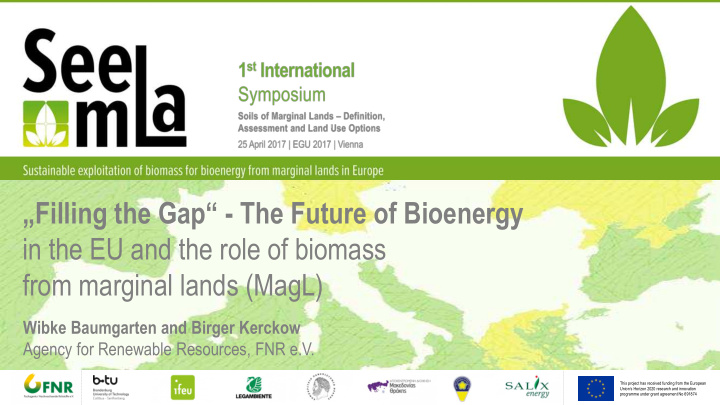



Sustainable exploitation of biomass for bioenergy from marginal lands (MagL) in Europe „Filling the Gap“ - The Future of Bioenergy in the EU and the role of biomass from marginal lands (MagL) Wibke Baumgarten and Birger Kerckow Agency for Renewable Resources, FNR e.V. Partners Project coordinator This project has received funding from the European Union‘s Horizon 2020 research and innovation programme under grant agreement No 691874
Sustainable exploitation of biomass for bioenergy from marginal lands (MagL) in Europe H2020 funded project SEEMLA Sustainable exploitation of biomass for bioenergy from marginal lands (MagL) in Europe Duration: 01/2016 – 12/2018 Partner countries: Greece, Italy, Ukraine and Germany www.seemla.eu Eight partners and four pilot case areas in Greece, Ukraine and Germany Main objectives: (i) the promotion of re-conversion of MagLs for the production of bioenergy through the direct involvement of farmers and forester (ii) the strengthening of local small-scale supply chains (iii) the promotion of plantations of bioenergy plants on MagLs Partners Project coordinator This project has received funding from the European Union‘s Horizon 2020 research and innovation programme under grant agreement No 691874
Sustainable exploitation of biomass for bioenergy from marginal lands (MagL) in Europe Primary biomass demand in 2020 and biomass potential in EU Member States (MS) Scarlat, N., Dallemand, J.-F., Monforti-Ferrario, F., Banja, M., Motola, V., 2015. Renew. Sustain. Energy Rev., 51:969-985 Partners Project coordinator This project has received funding from the European Union‘s Horizon 2020 research and innovation programme under grant agreement No 691874
Sustainable exploitation of biomass for bioenergy from marginal lands (MagL) in Europe “Filling the Gap” of future domestic biomass demand Energy scenario for Germany 2050 not feasible only with biobased residual and waste materials FNR, 2016 based on and modified after AGEB 2015, BMWi (forecast) 2014 Partners Project coordinator This project has received funding from the European Union‘s Horizon 2020 research and innovation programme under grant agreement No 691874
Sustainable exploitation of biomass for bioenergy from marginal lands (MagL) in Europe Marginal Sites in Germany First estimation according to DUTH ca. 0.9 Mio. ha MagL in Germany GIS analysis based on the Muencheberg SQR Tool for agricultural land (incl. percip.) Scale 1:1 Mio. (cf. BGR) Partners Project coordinator This project has received funding from the European Union‘s Horizon 2020 research and innovation programme under grant agreement No 691874
Sustainable exploitation of biomass for bioenergy from marginal lands (MagL) in Europe Catalogue bioenergy plants MagL Miscanthus Switchgrass Cup plant ( Silphium ) Basket willow ( Salix ) Poplar ( Populus ) Robinie IBC&SB, 2016 Partners Project coordinator This project has received funding from the European Union‘s Horizon 2020 research and innovation programme under grant agreement No 691874
Sustainable exploitation of biomass for bioenergy from marginal lands (MagL) in Europe Partners Project coordinator This project has received funding from the European Union‘s Horizon 2020 research and innovation programme under grant agreement No 691874
Sustainable exploitation of biomass for bioenergy from marginal lands (MagL) in Europe (i) The CAP provides the possibility to support investments and infrastructure related the establishment of energy crops such as Short Rotation Coppices (SRC) and of other grasses for energy purposes, i.e. miscanthus, switch grass, reed canary grass, etc. (ii) The exploitation of biomass production for bioenergy on MagL will offer a considerable potential in order to be able to meet the 2020 targets and beyond. Partners Project coordinator This project has received funding from the European Union‘s Horizon 2020 research and innovation programme under grant agreement No 691874
Sustainable exploitation of biomass for bioenergy from marginal lands (MagL) in Europe Thank you for your attention! Partners Project coordinator This project has received funding from the European Union‘s Horizon 2020 research and innovation programme under grant agreement No 691874
Recommend
More recommend